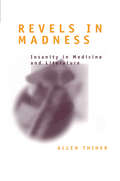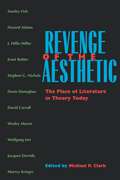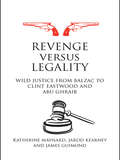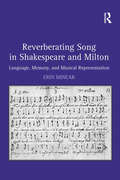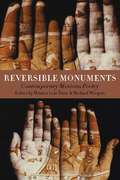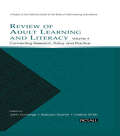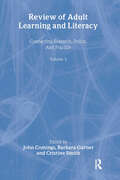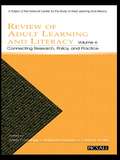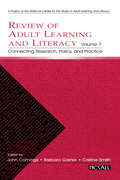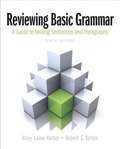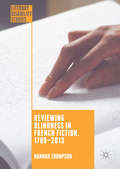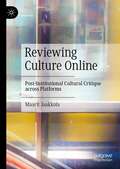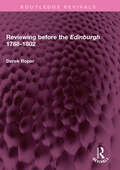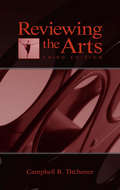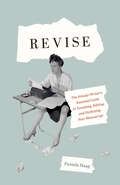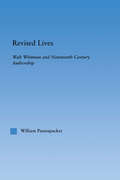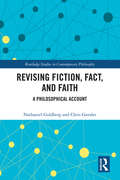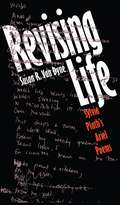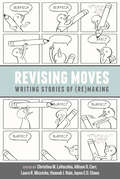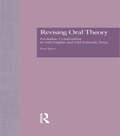- Table View
- List View
Revelations-2 (Basic English Textbook and Workbook BA Semester- 2)
by Dr Kavita KusugalRevelations-2 (Basic English Textbook and Workbook BA Second Semester of Rani Channamma University.
Revels in Madness: Insanity in Medicine and Literature
by Allen ThiherIn Revels in Madness, Allen Thiher surveys a remarkable range of writers as he shows how conceptions of madness in literature have reflected the cultural assumptions of their era. Thiher underscores the transition from classical to modern theories of madness-a transition that began at the end of the Enlightenment and culminates in recent women's writing that challenges the postmodern understanding of madness as a fall from language or as a dysfunction of culture.
Revenge Tragedy and the Drama of Commemoration in Reforming England (Studies in Performance and Early Modern Drama)
by Thomas RistConsidering major works by Kyd, Shakespeare, Middleton and Webster among others, this book transforms current understanding of early modern revenge tragedy. Examing the genre in light of historical revisions to England's Reformations, and with appropriate regard to the social history of the dead, it shows revenge tragedy is not an anti-Catholic and Reformist genre, but one rooted in, and in dialogue with, traditional Catholic culture. Arguing its tragedies are bound to the age's funerary performances, it provides a new view of the contemporary theatre and especially its role in the religious upheavals of the period.
Revenge of the Aesthetic: The Place of Literature in Theory Today
by Michael P. ClarkThis cutting-edge collection of essays showcases the work of some of the most influential theorists of the past thirty years as they grapple with the question of how literature should be treated in contemporary theory. The contributors challenge trends that have recently dominated the field--especially those that emphasize social and political issues over close reading and other analytic methods traditionally associated with literary criticism. Written especially for this collection, these essays argue for the importance of aesthetics, poetics, and aesthetic theory as they present new and stimulating perspectives on the directions which theory and criticism will take in the future. In addition to providing a selection of distinguished critics writing at their best, this collection is valuable because it represents a variety of fields and perspectives that are not usually found together in the same volume. Michael Clark's introduction provides a concise, cogent history of major developments and trends in literary theory from World War II to the present, making the entire volume essential reading for students and scholars of literature, literary theory, and philosophy.
Revenge versus Legality: Wild Justice from Balzac to Clint Eastwood and Abu Ghraib (Birkbeck Law Press)
by Katherine Maynard Jarod Kearney James GuimondIn the wake of Guantanamo Bay, extraordinary renditions, and secret torture centres in Eastern Europe and elsewhere, Revenge versus Legality addresses the relationship between law and wild or vigilante justice; between the power to enforce retribution and the desire to seek revenge. Taking up a variety of narratives from the eras of Romanticism, Realism, Modernism and the Contemporary period, and including new theories to explain the interactions that occur between legalistic courtroom justice and the vigilante variety, Revenge versus Legality analyzes some of the main obstacles to justice, ranging from judicial corruption, to racism and imperialism. The book culminates in a consideration of that form of crime or lawlessness that poses the most serious threat to the rule of law: vigilante justice masquerading as legality. With its mixture of politics, literature, law, and film, this lively and accessible book offers a timely reflection on the enduring phenomenon of revenge.
Reverberating Song in Shakespeare and Milton: Language, Memory, and Musical Representation
by Erin MinearIn this study, Erin Minear explores the fascination of Shakespeare and Milton with the ability of music-heard, imagined, or remembered-to infiltrate language. Such infected language reproduces not so much the formal or sonic properties of music as its effects. Shakespeare's and Milton's understanding of these effects was determined, she argues, by history and culture as well as individual sensibility. They portray music as uncanny and divine, expressive and opaque, promoting associative rather than logical thought processes and unearthing unexpected memories. The title reflects the multiple and overlapping meanings of reverberation in the study: the lingering and infectious nature of musical sound; the questionable status of audible, earthly music as an echo of celestial harmonies; and one writer's allusions to another. Minear argues that many of the qualities that seem to us characteristically 'Shakespearean' stem from Shakespeare's engagement with how music works-and that Milton was deeply influenced by this aspect of Shakespearean poetics. Analyzing Milton's account of Shakespeare's 'warbled notes,' she demonstrates that he saw Shakespeare as a peculiarly musical poet, deeply and obscurely moving his audience with language that has ceased to mean, but nonetheless lingers hauntingly in the mind. Obsessed with the relationship between words and music for reasons of his own, including his father's profession as a composer, Milton would adopt, adapt, and finally reject Shakespeare's form of musical poetics in his own quest to 'join the angel choir.' Offering a new way of looking at the work of two major authors, this study engages and challenges scholars of Shakespeare, Milton, and early modern culture.
Reversible Monuments
by Michael Wiegers Mónica de la Torre Alastair ReidNot since 1959 when Octavio Paz and Samuel Beckett published An Anthology of Mexican Poetry, has there been a collection which so thoroughly examines the poetry of the country known for being "too far from God and too close to the United States." Yet, as Elliott Weinberger writes in his introduction,"Americans know everything about God, but next to nothing about Mexico--few know that Mexico-particularly when compared to the United States-is a kind of paradise for poets."Reversible Monuments introduces this "paradise" to American readers. It includes major international writers like Alberto Blanco, Pura Lopez Colome, and David Huerta, as well as exciting younger poets, and poets whose work, while well-known in the Spanish-speaking world has not yet seen publication in English. The twenty-five poets represented are as diverse as their American counterparts: They are urban, educated, younger, well travelled, aware of their literary heritage, and include Buddhists, feminists, Jewish poets, experimental poets, darkly brooding poets, and playfully entertaining poets. Until the Poem Remainsby Francisco HernandezStrip away all the fleshuntil the poem remainswith the sonorous darkness of bone.And smooth the bone, polish it, sharpen ituntil it becomes such a fine needle,that it pierces the tongue without painthough blood chokes the throat. Reversible Monuments includes a healthy bilingual selection by each poet, features an introduction by Elliott Weinberger, and gathers the work of esteemed translators alongside that of younger translators. It also includes biographies of the poets, notes on the poetry, and an extensive bibliography of contemporary Mexican poetry.
Review of Adult Learning and Literacy, Volume 4: Connecting Research, Policy, and Practice: A Project of the National Center for the Study of Adult Learning and Literacy
by Cristine Smith Barbara Garner John ComingsThe Review of Adult Learning and Literacy: Connecting Research Policy, and Practice, Volume 4 is the newest addition to a series of annual publications of the National Center for the Study of Adult Learning and Literacy (NCSALL) that address major issues, the latest research, and the best practices in the field of adult literacy and learning. Volume 4 opens with an overview of significant recent developments in the field. Subsequent chapters cover a wide range of topics critical to the success of adult education and literacy services in the United States: *issues of race, class, gender, and sexual orientation; *the role of workplace education in building adults' basic skills; *the role of new learning technologies in adult education and literacy; *adult developmental theories and their implications for the teaching of adult basic education and English for speakers of other languages; and *traditional and contemporary adult learning theories, including an annotated bibliography of key resources. Intended for policymakers, scholars, and practitioners dedicated to improving the quality of adult basic education, adult English for speakers of other languages, and adult secondary education programs, Review of Adult Learning and Literacy, Volume 4 is an essential resource for the field.
Review of Adult Learning and Literacy, Volume 5: Connecting Research, Policy, and Practice: A Project of the National Center for the Study of Adult Learning and Literacy
by Cristine Smith Barbara Garner John ComingsThe Review of Adult Learning and Literacy: Connecting Research, Policy, and Practice, Volume 5 is the newest volume in a series of annual publications of the National Center for the Study of Adult Learning and Literacy (NCSALL) that address major issues, the latest research, and the best practices in the field of adult literacy and learning.Each Review opens with an overview of significant recent developments in the field of adult literacy during the year, followed by a set of chapters presenting in-depth reviews of research and best practices on topics of high interest to the field. Volume 5 includes chapters on:*the increasing emphasis on scientifically based research and evidence-based practice in education, their use in adult literacy, and the perception of their usefulness by those who work in the field;*recent research on the impact of acquiring a General Educational Development (GED) credential;*the adult literacy system in the state of Massachusetts, focusing on the factors that led to investing and restructuring in the system, and the lessons learned that may be helpful to other states interested in building strong systems of educational service delivery for adult learners;*a history and review of volunteerism in adult literacy;*the history and structure of the adult literacy system in New Zealand, including policy recommendations for the current system to more effectively serve all adult learners; and*a review of theories and key resources related to metacognitive skills in reading.The Review of Adult Learning and Literacy serves as the journal of record for the field and is an essential resource for all stakeholders who need to know what research can reveal about how best to serve adult learners.
Review of Adult Learning and Literacy, Volume 6: Connecting Research, Policy, and Practice: A Project of the National Center for the Study of Adult Learning and Literacy (J-b Annual Review Of Adult Learning And Literacy Ser. #6)
by Cristine Smith Barbara Garner John ComingsReview of Adult Learning and Literacy: Connecting Research, Policy, and Practice, Volume 6, includes chapters on:*Demographic change and low-literacy Americans;*The role of vocabulary in Adult Basic Education;*Implications of research on spelling for Adult Basic Education;*Issues in teaching speaking skills to adult ESOL learners;*The preparation and stability of the Adult Basic Education teaching workforce;*The adult literacy system in Ireland; and*Broad-based organizing as a vehicle for promoting adult literacy..
Review of Adult Learning and Literacy, Volume 7: Connecting Research, Policy, and Practice
by Cristine Smith Barbara Garner John P. ComingsReview of Adult Learning and Literacy: Connecting Research, Policy, and Practice, Volume 7, is the newest volume in a series of annual publications of the National Center for the Study of Adult Learning and Literacy (NCSALL) that address major issues, the latest research, and the best practices in the field of adult literacy and learning. Each Review opens with an overview of significant recent developments in the field of adult literacy followed by a set of chapters presenting in-depth reviews of research and best practices on topics of high interest to the field, and concludes with a Resources section. Chapter topics in Volume 7:*Persistence: Helping Adult Students Reach Their Goals*Achieving Adult Education Program Quality*Assistive Technology and Adult literacy*Individualized Group Instruction*Health Literacy*Research on Professional Development and Teacher Change*Opportunities, Transitions, and Risks: Perspectives on Adult Literacy and Numeracy Development in Australia*Adult Basic Education in South Africa*Annotated Bibliography on Workplace Education The Review of Adult Learning and Literacy serves as the journal of record for the field and is an essential resource for all stakeholders who need to know what research can reveal about how best to serve adult learners. The National Center for the Study of Adult Learning and Literacy (NCSALL) is a federally funded research and development center focused solely on adult learning. NCSALL's efforts are dedicated to improving practice in educational programs that serve adults with limited literacy and English language skills, and those without a high school diploma. For more information on NCSALL, please visit http://www.ncsall.net/.
Reviewing Basic Grammar (Ninth Edition)
by Mary Laine Yarber Robert YarberReviewing Basic Grammar uses a step-by-step approach to combine an intense grammar review with an introduction to paragraph writing.
Reviewing Blindness in French Fiction, 1789–2013
by Hannah ThompsonThis book argues that the most interesting depictions of blindness in French fiction are those which call into question and ultimately undermine the prevailing myths and stereotypes of blindness which dominate Western thought. Rather than seeing blindness as an affliction, a tragedy or even a fate worse than death, the authors examined in this study celebrate blindness for its own sake. For them it is a powerful artistic and creative force which offers new and surprising ways of describing, and relating to, reality. Canonical and lesser-known novels from a range of genres, including the roman noir, science fiction, auto-fiction and realism are analyzed in detail to show how the presence of blind characters invites the reader to abandon his or her traditional reliance on the sense of sight and engage with the world in sensual, and hitherto unexpected, ways. This book challenges everything we thought we knew about blindness and invites us to revel in the pleasures and perils of reading blind.
Reviewing Culture Online: Post-Institutional Cultural Critique across Platforms
by Maarit JaakkolaThis book examines how ordinary users review cultural products online, ranging from books to films and other art objects to consumer products. The book maps different communities—in institutional and non-institutional settings—which intersect with the genre of review, especially in the social web where reviewing is conducted on platforms such as Instagram, YouTube and Vimeo. The book, drawing on the key concepts of cultural intermediation, platformized cultural production and post-professionalism, looks at user-generated content in lifestyle communities beyond the binary of professional and amateur production.
Reviewing Mario Pratesi
by Anne UrbancicA prolific member of the Tuscan verismo school of literary realism, Mario Pratesi (1842-1921) was much respected during his career but sadly neglected after his death. Using Pratesi's personal archive, now preserved at Victoria College in the University of Toronto, Reviewing Mario Pratesi takes Pratesi's life and papers as the basis of a unique study of the literary culture of post-Unification Italy.Working with the original manuscripts, alongside previously unknown biographical materials and a vast collection of contemporary reviews, Anne Urbancic uses the methods of critique génétique not only to reconstruct the evolution of Pratesi's works through their successive drafts and published versions, but also to document the impact of book reviews and the press on the development of Pratesi's literary style. An insightful history of book reviewing as a genre and a detailed study of its role in Italian literary culture, Reviewing Mario Pratesi opens up a new area for investigation within Italian literary studies.
Reviewing Shakespeare
by Paul PrescottRanging from David Garrick's Macbeth in the 1740s to the World Shakespeare Festival in London 2012, this is the first book to provide in-depth analysis of the history and practice of Shakespearean theatre reviewing. Reviewing Shakespeare describes the changing priorities and interpretative habits of theatre critics as they have both responded to and provoked innovations in Shakespearean performance culture over the last three centuries. It analyses the conditions – theatrical, journalistic, social and personal – in which Shakespearean reception has taken place, presenting original readings of the works of key critics (Shaw, Beerbohm, Agate, Tynan), whilst also tracking broader historical shifts in the relationship between reviewers and performance. Prescott explores the key function of the 'night-watch constable' in patrolling the boundaries of legitimate Shakespearean performance and offers a compelling account of the many ways in which newspaper reviews are uniquely fruitful documents for anyone interested in Shakespeare and the theatre.
Reviewing before the Edinburgh 1788-1802 (Routledge Revivals)
by Derek RoperFirst published in 1978, Reviewing before the Edinburgh is a study of English literary reviewing during the fifteen years before the founding in1802 of the Edinburgh Review, and an assessment of the reviewers’ achievement. The long introductory chapter describes the aims, methods, staffing, readership, influence, and development of the five important Reviews of the 1790s: the Monthly Review, Critical Review, English Review, Analytical Review, and British Critic. The author argues that this type of Review declined during the 19th century, not because of poor performance, but because the ambitious aim of comprehensive reviewing had become impossible to achieve. The remaining chapters discuss and evaluate the work of these Reviews, chiefly in the fields of poetry, fiction, and political and religious controversy. The book fills a gap in the literary and political history of the period; provides a compact summary of its review criticism; and gives a better perspective on both reviewers and reviewed in years that were unusually fertile in political controversy and literary experiment. It will be of interest to students of literature and history.
Reviewing the Arts
by Campbell B. TitchenerReviewing the Arts is written for those media writers assigned to review an artistic event or performance, providing the tools for a journalist to write informed and enlightened reviews of the arts. This useful text guides writers through the steps for producing an acceptable review of fine and performing arts, covering the range of arts from film and television to drama and dance; from sculpture and architecture to music. Author Campbell Titchener suggests ways to approach both familiar and unfamiliar art forms to prepare an informed evaluation, and in this updated third edition he includes current examples from practicing journalists and veteran critics. This practical text fits readily into the journalism curriculum, and will be a useful resource for practicing journalists.
Revise: The Scholar-Writer’s Essential Guide to Tweaking, Editing, and Perfecting Your Manuscript
by Pamela HaagA helpful, engaging guide to the revision of scholarly writing by an editor and award-winning author &“Pamela Haag has been called &‘the tenure whisperer&’ for good reason. Any scholar who hopes to attract a wider audience of readers will benefit from the brilliant, step-by-step guidance shared here. It&’s pure gold for all aspiring nonfiction writers.&”—Nancy MacLean, author of Democracy in Chains: The Deep History of the Radical Right&’s Stealth Plan for America Writing and revision are two different skills. Many scholar-writers have learned something about how to write, but fewer know how to read and revise their own writing, spot editorial issues, and transform a draft from passable to great. Drawing on before and after examples from more than a decade as a developmental editor of scholarly works, Pamela Haag tackles the most common challenges of scholarly writing. This book is packed with practical, user-friendly advice and is written with warmth, humor, sympathy, and flair. With an inspiring passion for natural language, Haag demonstrates how to reconcile clarity with intellectual complexity. Designed to be an in-the-trenches desktop reference, this indispensable resource can help scholars develop a productive self-editing habit, advise their graduate and other students on style, and, ultimately, get their work published and praised.
Revised Lives: Whitman, Religion, and Constructions of Identity in Nineteenth-Century Anglo-American Culture (Literary Criticism and Cultural Theory)
by William PannapackerFirst published in 2004. Routledge is an imprint of Taylor & Francis, an informa company.
Revised New Oxford Modern English Coursebook 1 - ICSE
by David Horsburgh Nicholas Horsburgh Claire HorsburghThe Coursebooks offer lively and engaging reading passages for children, with a graded vocabulary. They include a diverse range of content such as new stories, factual accounts, contemporary fiction, and traditional folk stories. Each book incorporates drama and poetry, providing a comprehensive reading experience. The accompanying exercises reinforce learning by allowing active practice and catering to varying abilities. The workbook complements the Coursebooks by providing additional grammar drills and language skill practice. It also includes three tests, one for each school term, to assess the students' progress. Overall, the Coursebooks and Workbooks aim to develop reading, comprehension, language, listening, speaking, and writing skills in children.
Revising Fiction, Fact, and Faith: A Philosophical Account (Routledge Studies in Contemporary Philosophy)
by Chris Gavaler Nathaniel GoldbergThis book addresses how our revisionary practices account for relations between texts and how they are read. It offers an overarching philosophy of revision concerning works of fiction, fact, and faith, revealing unexpected insights about the philosophy of language, the metaphysics of fact and fiction, and the history and philosophy of science and religion. Using the novels of J.R.R. Tolkien as exemplars, the authors introduce a fundamental distinction between the purely physical and the linguistic aspects of texts. They then demonstrate how two competing theories of reference—descriptivism and referentialism—are instead constitutive of a single semantic account needed to explain all kinds of revision. The authors also propose their own metaphysical foundations of fiction and fact. The next part of the book brings the authors’ philosophy of revision into dialogue with Thomas Kuhn’s famous analysis of factual, and specifically scientific, change. It also discusses a complex episode in the history of paleontology, demonstrating how scientific and popular texts can diverge over time. Finally, the authors expand their philosophy of revision to religious texts, arguing that, rather than being distinct, such texts are always read as other kinds, that faith tends to be more important as evidence for religious texts than for others, and that the latter explains why religious communities tend to have remarkable historical longevity. Revising Fiction, Fact, and Faith offers a unique and comprehensive account of the philosophy of revision. It will be of interest to a wide range of scholars and advanced students working in philosophy of language, metaphysics, philosophy of literature, literary theory and criticism, and history and philosophy of science and religion.
Revising Life
by Susan R. Van Dyne'Provides a compelling argument for Plath's revision of the painful parts of her life--the failed marriage, her anxiety for success, and her ambivalence towards her mother. . . . The reader will feel the tension in the poetry and the life.'Choice '[Examines] Plath's twin goals of becoming a famous poet and a perfect mother. . . . This book's main points are clearly and forcefully argued: that both poems and babies require 'struggle, pain, endless labor, and . . . fears of monstrous offspring' and that, in the end, Plath ran out of the resources necessary to produce both. Often maligned as a self-indulgent confessional poet, Plath is here retrieved as a passionate theorist.'--Library Journal Susan Van Dyne's reading of twenty-five of Sylvia Plath's Ariel poems considers three contexts: Plath's journal entries from 1957 to 1959 (especially as they reveal her conflicts over what it meant to be a middle-class wife and mother and an aspiring writer in 1950s America); the interpretive strategies of feminist theory; and Plath's multiple revisions of the poems.
Revising Moves: Writing Stories of (Re)Making
by Hannah J. Rule Laura R. Micciche Christina M. LaVecchia Allison D. Carr Jayne E. O. StoneRevision sometimes seems more metaphor than real, having been variously described as a stage, an act of goal setting, a method of correction, a process of discovery, a form of resistance. Revising Moves makes a significant contribution to writing theory by collecting stories of revision that honor revision’s vitality and immerse readers in rooms, life circumstances, and scenes where revision comes to life. In these narrative-driven essays written by a wide range of writing professionals, Revising Moves describes revision as a messy, generative, and often collaborative act. These meditations reveal how revision is both a micro practice tracked by textual change and a macro phenomenon rooted in family life, institutional culture, identity commitments, and political and social upheaval. Contributors depict revision as a holistic undertaking and a radically contextualized, distributed practice that showcases its relationality to everything else. Authors share their revision processes when creating scholarly works, institutional and self-promoting documents, and creative projects. Through narrative the volume opens a window to what is often unseen in a finished text: months or years of work, life events that disrupt or alter writing plans, multiple draft changes, questions about writerly identity and positionality, layers of (sometimes contradictory) feedback, and much more.
Revising Oral Theory: Formulaic Composition in Old English and Old Icelandic Verse (Garland Studies in Medieval Literature #Vol. 16)
by Paul AckerFirst published in 1998. Routledge is an imprint of Taylor & Francis, an informa company.

